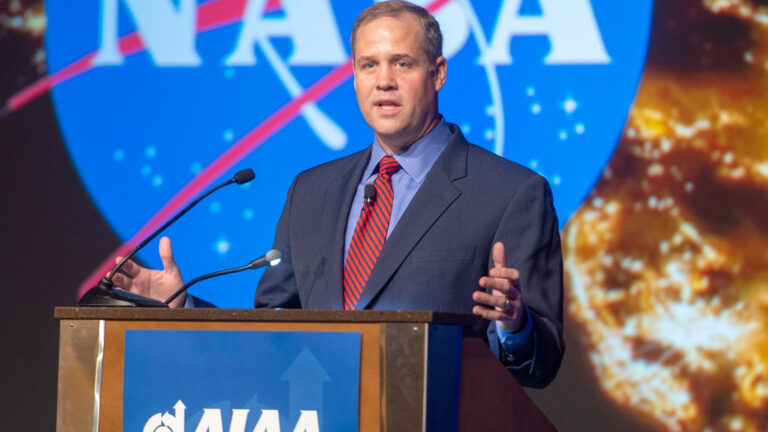Stay Up to Date
Submit your email address to receive the latest industry and Aerospace America news.
NASA administrator suggests that space cooperation with China could be part of grand bargain
AIAA SPACE FORUM, Orlando, Fla. — NASA Administrator Jim Bridenstine said the Trump administration’s goal of landing Americans on the surface of the moon and someday Mars will require companies and international partners, because “we want to do more than even our growing budget can handle.”
I interviewed Bridenstine Monday after his keynote address here.
“We have to have international partners, we have to have commercial partners, and we need to build an architecture where everybody has a piece to play,” Bridenstine said. Otherwise, a program to return to the moon won’t be “sustainable,” he added.
The International Space Station “is a model for international partnership going forward,” he said, noting the cooperation in space with Russia’s space agency Roscosmos that has been “very positive for both countries.” Bridenstine will travel to Kazakhstan in October to meet his Roscosmos counterpart, Dmitry Rogozin, in person for the first time and watch NASA astronaut Nick Hague and Russian cosmonaut Aleksey Ovchinin launch to the International Space Station aboard a Russian-built Soyuz rocket. Bridenstine and Rogozin spoke to each other during a Sept. 12 teleconference.
Bridenstine said he would “absolutely” be open to American astronauts flying to the moon or Mars with astronauts from Russia or other countries who partner with NASA on exploration.
“I would forsee a future where we are launching on Soyuz rockets and they are launching on America’s commercial crew rockets,” he said. “It’s a great relationship, we need to maintain it. At the same time, we need to have our own capabilities.”
Bridenstine was referring to U.S. reliance on Russia for flights to space since the retirement of the space shuttle fleet in 2011, but NASA has selected crew to fly to the station from U.S. soil on the Boeing Starliner and the SpaceX Dragon capsules in 2019, if all goes as planned.
Bridenstine, who was a congressman from Oklahoma from 2012 until earlier this year, said Congress recognizes the need for détente with Russia in the area of space exploration, even though there are “a lot” of tensions with the U.S. and its allies, “now probably more than ever.” When there are sanctions against Russia, he said U.S. lawmakers “carve out space because it is in our interest to carve out space.”
Such a partnership on space exploration has not yet been established with China, given that in 2011 Congress banned NASA from working directly with China and has reauthorized the prohibition every subsequent budget cycle, including during Bridenstine’s terms. “Russia is an incumbent,” he said, but “there is a lot that has to be negotiated” before his former colleagues in Congress will be willing to forge a space partnership with China.
National security flashpoints with China he cited include that nation’s contested claim to airspace over the South China Sea and its launch of a missile to destroy one of its own satellites in 2007, which created a debris field in orbit that is hazardous to other spacecraft. Despite those tensions, Bridenstine said the possibility of a space exploration partnership with NASA “should be something on the table if some grand bargain can be achieved between the U.S. and China.”
China before the end of 2018 plans to launch its Chang’e 4 probe to land on the far side of the moon and relay signals home through a satellite in lunar orbit. “We wish them well,” Bridenstine said.
Russia and the U.S. announced last year they are discussing potential designs for the Lunar Orbital Platform-Gateway, a space station that NASA plans to launch in several pieces and assemble in lunar orbit.
About Tom Risen
As our staff reporter from 2017-2018, Tom covered breaking news and wrote features. He has reported for U.S. News & World Report, Slate and Atlantic Media.
Related Posts
Stay Up to Date
Submit your email address to receive the latest industry and Aerospace America news.




